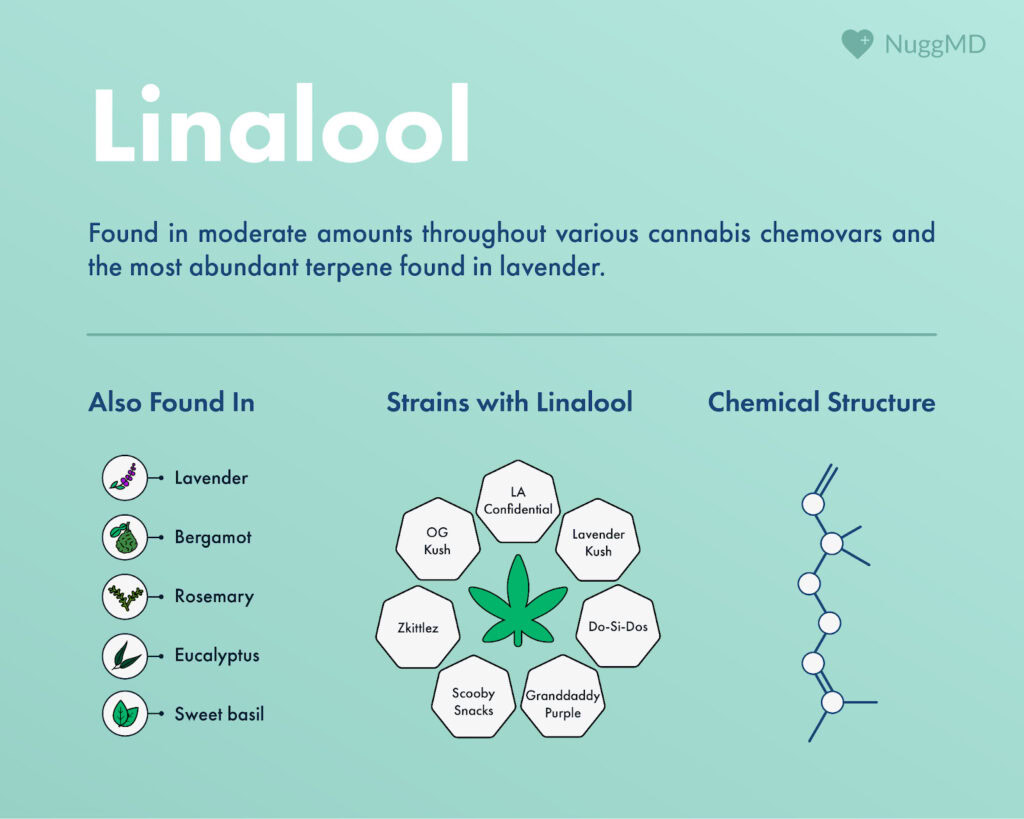Key Takeaways
- The linalool terpene is one of many aromatic compounds in cannabis that may contribute to its effects.
- Linalool is known to be calming and is also found in plants like lavender, bergamot, and rosemary.
- For strains high in linalool, try LA Confidential, OG Kush, or Granddaddy Purple.
Terpenes are aromatic compounds found throughout the plant kingdom. They help defend flora from threats and contribute to each species’ unique character. In cannabis, terpenes often take a backseat to THC and CBD, though they still deserve attention.
In cannabis, well over 100 terpenes and newly discovered flavorants can play a prominent role in shaping a strain’s taste, aroma, and effect. Among the hundreds identified in cannabis, the linalool terpene stands out for its sweet, lavender-like profile and various potential beneficial effects.
What is Linalool?
Linalool is a natural monoterpene found in flowers, spices, and herbs. It’s often associated with lavender. Cannabis strains with linalool in their profiles tend to contain fresh floral aromas with sweet, woody, or subtly spicy notes. The terpene is known for more than just pleasant aromas and flavors, with linalool cited for its potential healing effects. These include but aren’t limited to anxiety and stress relief, anti-inflammatory properties, and improved sleep.1
Chemically, linalool appears in two primary forms: licareol (3R enantiomer) and coriandrol (3S enantiomer). Their aromas and effects differ to a slight degree. However, the difference between the two is minor enough that most products won’t identify which form of the terpene appears in products.2
Beyond cannabis, linalool is a core component of numerous plants, including coriander and bergamot. In cannabis, linalool levels vary by strain. Even a modest concentration of the terpene can result in cultivars possessing a noticeable lavender-like, floral fragrance.
What Does Linalool Smell Like?

Linalool’s aroma profile is pleasant and complex, with supporting notes aiding the floral-heavy strain to create an array of robust, unique buds. The common aromatic and flavor notes in a linalool strain include:
- Earth (Floral, Woody): A core predominant aroma of fresh flowers with mild woody notes.
- Spicy: A supporting subtle spicy note, like bergamot or coriander.
- Sweet: Some strains contain muted tropical notes.
Like in bergamot, this monoterpene is a strong scent overall. With a combination of French lavender, wood, sweets, spice, and a bit of tropical zest, linalool offers a range of pleasant scents and flavors.1
Effects and Benefits of Linalool

Linalool may offer relaxing, mood-lifting effects. More specifically, linalool’s potential beneficial effects are often summarized by three broad outcomes:
- Calming: Linalool’s soothing properties have been linked to providing soothing effects that may help some consumers with reduced feelings of stress and anxiety.
- Mood Elevation: In addition to easing mental stress, linalool’s soothing properties have been known to promote uplifted moods, including in individuals with depression.
- Improved Sleep Quality: By easing anxieties and uplifting moods, consumers may find themselves in a better state for a good night's rest. Being potentially sedative, these effects may help improve sleep for some consumers.
In cannabis, it’s rarely about one single compound, be it THC, CBD, linalool, or any other. Linalool works with a cannabis strain’s hundreds of other compounds to create a unique, comprehensive, synergistic effect known by many as the entourage effect.1,2
What Other Plants Contain Linalool?

Far from exclusive to cannabis, linalool is a terpene common to many herbs and botanicals, appearing in countless foods, flowers, and wellness plans.2 Some of the most common sources of linalool include:
- Lavender: Regarded for its calming effects, it is widely used in essential oils as part of aromatherapy treatments.
- Bergamot: A key ingredient in Earl Grey tea’s floral-citrus notes, bergamot is regarded for its anxiety-inhibiting effects. Like lavender, the flower is also regarded for its beneficial healing properties in aromatherapy.
- Coriander: Adds slightly sweet, somewhat spicy notes to dishes.
- Orange: This citrus scent occasionally pairs with relaxing properties and is another linalool-rich aromatherapy option.
Like cannabis, plants, beverages, and foods that contain linalool have unique profiles, including varying terpene levels. In some cases, linalool plays a prominent role, making detecting it easier. In other cases, it may be a less noticeable component, making its notes subtle or undetectable.
What Conditions Can Linalool Help With?
Growing clinical analysis has helped confirm many claims about linalool’s beneficial effects. As such, many cannabis consumers use linalool-present strains to address several medical conditions and symptoms, such as:
- Stress
- Anxiety
- Difficulty Sleeping
- Mild Mood Imbalances
- Minor Physical Discomfort
Everyone is different, as dosage varies by person. No universal dosage guidelines exist, so patients must experiment to find a serving size that delivers their ideal outcome. With such ambiguity, consumers should consider speaking with a trusted physician to understand better how linalool or cannabis, in general, may affect them.2
Best Strains for Linalool

Everyone has their preferences and needs, making one person’s top pick an afterthought to the next consumer. When starting out, consider some of the top-rated and highly sought-after linalool-rich cultivars, such as:
LA Confidential
LA Confidential is known for deep, body-centered relaxation effects, with linalool’s presence felt in subtle ways through its earth and floral undertones.
OG Kush
OG Kush is a cannabis staple for many. Often regarded for its notes of pine and lemon zest, elevated linalool levels can help this strain produce mild lavender notes with a usually uplifting, calming experience.
Granddaddy Purple
Known for grape notes and sedative effects, Granddaddy Purple is a caryophyllene- and myrcene-dominant strain. Still, moderate linalool levels have been known to amplify this popular strain’s comforting qualities.
Scooby Snacks
Zoinks! This lesser-known cultivar blends sweet, light herbal notes with higher linalool levels, delivering subtle floral notes and feelings of euphoria and calm.
Do-Si-Dos
Do-Si-Dos is pungent and sweet with a high potential for relaxation, with linalool playing a role.
References
- Pereira I, Severino P, Santos AC, Silva AM, Souto EB. Linalool bioactive properties and potential applicability in drug delivery systems. Colloids and Surfaces B Biointerfaces. 2018;171:566-578. doi:https://doi.org/10.1016/j.colsurfb.2018.08.001 ↩︎
- dos Santos ÉRQ, Maia JGS, Fontes-Júnior EA, do Socorro Ferraz Maia C. Linalool as a Therapeutic and Medicinal Tool in Depression Treatment: A Review. Current Neuropharmacology. 2022;20(6):1073-1092. doi:https://doi.org/10.2174/1570159x19666210920094504 ↩︎
The information in this article and any included images or charts are for educational purposes only. This information is neither a substitute for, nor does it replace, professional legal advice or medical advice, diagnosis, or treatment. If you have any concerns or questions about laws, regulations, or your health, you should always consult with an attorney, physician or other licensed professional.




